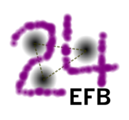In recent years, there has been a rapidly growing interest in ultracold hybrid atomic-ion systems. It is caused by the new opportunities opening here for modeling various quantum system and processes with controllable properties. Particularly, in the recent paper of Melezhik and Negretti[1] the confinement-induced resonances (CIRs) in ultracold hybrid atom-ion systems were predicted, which can...
Mesonic atoms are the Coulomb bound systems of a nucleus and mesons. They interact with short-range strong interactions in addition to the long-range Coulomb potential. Studies of such kind of systems lead to the understanding of the short-range interactions such as meson-nucleon interactions. In Ref. [J.-M. Richard, C. Fayard, Phys. Lett. A 381, 3217-3221 (2017)], a system consisting of...
We present a lattice method for determining scattering phase shifts and mixing angles for the case of an arbitrary number of coupled channels. Previous lattice studies were restricted to mixing of up to two partial waves for scattering of two spin-$1/2$ particles, which is insufficient for analyzing nucleon-nucleus or nucleus-nucleus scattering processes. In the proposed method, the phase...
Artificial Neural Networks (ANNs) have recently been used to solve a variety of quantum few- and many-body problems [1,2]. ANNs efficiently encapsulate information of the wavefunction and can be used to effectively solve variational problems [3]. I will discuss an implementation of these methods to solve a benchmark nuclear physics problem – the ground state of the deuteron [4]. I will...

